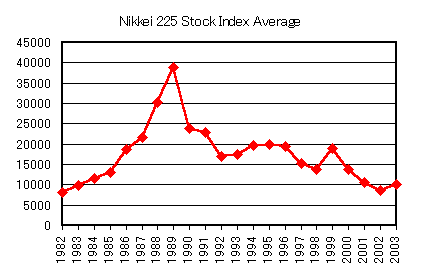
(See Handout no.13)
As you know, the Japanese economy is not doing well recently. Since the early 1990s when the asset bubble burst, Japan has suffered a slow and even negative growth coupled with price deflation. Economic statistics remain gloomy, and more importantly, the nation's mood (both consumers and producers) has become pessimistic. Some say Japan is still a very high income country. Others say transition to a new economy is being prepared under a recession and some companies are doing very well. But overall, it cannot be denied that Japan's economic performance in the last ten years was less than expected.
The 1990s is sometimes called the Lost Decade for Japan. So far, the 2000s also looks pretty bad. Some people fear that Japan will have the Lost Two Decades.
Naturally, the main topic of the Japanese economists today is why this recession continues, and what should be done to end it. The key policy issue at present seems to be whether or not bold reform measures should be taken at the time the economy is stagnant. Some argue that painful reform is necessary precisely when we face a recession. Others argue that such reform should not be undertaken in a bad economic situation. But there may be other important debate that economists are neglecting...
The government of prime minister Junichiro Koizumi (2001-) is trying to implement "reform" measures. This includes privatization of postal services, putting a stop to generous highway construction, and of course, the bank reform. But the worsening of the economic condition in 2001 due to the global IT recession and terrorist impact increased the opposition to the Koizumi initiative. In 2003 and 2004, the economic indicators began to pick up and the government is naturally happy. But we had similar signs of recovery in the past which did not materialize (see below).
Another problem is that while Mr. Koizumi is pro-reform, his party, Liberal Democratic Party (LDP), is mostly and traditionally anti-reform. In a sense, Koizumi is trying to implement a Minsei Party policy as a leader of Seiyukai-like party (see lecture 9). But because Koizumi is popular among Japanese people, old LDP politicians want to keep him to win votes. Thus, it is not very clear what message the voters are sending to the government when they support LDP: is it pro-reform or anti-reform?
The Japanese stock price index began to rise in the early 1980s and continued to rise to more than five times the 1980 level. Then, from 1990 it started a long period of decline with medium-term fluctuations.
The Japanese land price also rose throughout the 1980s and peaked in 1991. The average land price more than doubled. The turning point for the land price came one year later than the stock market, in 1991. Since then, the land price index has continued to decline even to date. Urban land prices rose more and fell harder. Rural land saw similar price movements but with a smaller amplitude.

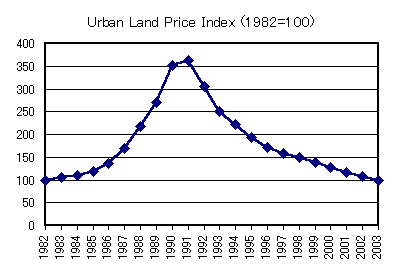
There are two alternative views regarding the cause of these asset bubbles.
The first view argues that the bubble was caused structurally through bank deregulation. Previously, Japanese banks were tightly regulated by the Ministry of Finance. There was little incentive to innovate, but as long as the banks remained in this regime, they were assured of an adequate profit margin and protected against bankruptcy. But this system began to be removed in the early 1980s. As competition began, banks lost "rents" and "franchise value" of being a bank (i.e., assured profits of being a (protected) bank). At the same time, large corporate customers moved away from bank borrowing toward other financing including retained profits, corporate bond issuance and access to international financial markets. As the Japanese banks lost large corporate customers, they rushed to find new (and more risky) borrowers and projects in (i) small and medium enterprises (SMEs) and (ii) land and property investment (especially urban office buildings and rural resort development). But the Japanese banks lacked the ability to correctly evaluate these new borrowers and projects. When the economy was booming in the late 1980s, they over-lent. When the bubble ended, these loans became a huge mountain of bad debt. This is the view presented by Masaru Yoshitomi.
The second view, which is more popular, is basically a monetary explanation of the bubble. It simply says that easy money in the late 1980s caused the asset bubble. In 1985 there was a sharp yen appreciation, and the Bank of Japan lowered short-term interest rates and eased money in response. The Bank of Japan's policy reaction function is such that traditionally, Japan's monetary policy responds positively (becomes expansionary) to (i) yen appreciation and (ii) domestic recession. Many blame the Bank of Japan (especially Governor Satoshi Sumita) for easing too much and too long. But since price inflation was close to zero at that time, the Bank of Japan could not find a good reason to tighten money and end the asset price increase everyone was enjoying. This was a signaling problem: when asset prices are rising but goods prices are stable, is liquidity excessive or not? The data shows that the growth of broad money (M2+CD) accelerated to more than 10% during 1987-89. This seemed a bit too high for an economy growing at about 4%. From end 1999, the new Bank of Japan governor Yasushi Mieno deliberately tightened money and raised interest rates. This quickly ended the bubble. Some blame Mr. Mieno for his brutality, but can the bubble go on forever? It had to end some time, and perhaps the sooner the better.
Maybe these two explanations are not mutually exclusive. Bank deregulation explains why reckless projects began to be financed at first and monetary expansion explains why this bubble continued for so long. They are structural and macroeconomic reasons, respectively, for the creation of the asset bubble.
During the late 1980s which was the rising phase of the bubble, many queer phenomena were observed.
--Those who had land became very rich and those who didn't had little chance of buying their home. This increased the sense of inequality and social injustice.--Enriched people purchased expensive clothes, cars, food, and so on. They also traveled all over the world to spend money (remember narikin during WW1?)
--Since vacant land was a more valuable asset (easier to sell) than built land, the yakuza (Japanese mafia) was mobilized to demolish the building illegally and forced the owner to sell the land. Sometimes the yakuza drove a truck into a house to destroy it.
--Too many office buildings were built in urban areas. They stood empty for many years to follow.
--Too many amusement parks and resort hotels were developed. The only hugely successful amusement park in Japan was (is) Tokyo Disneyland. All others got into financial troubles and many of them are now closed. Some of them are still operating under financial distress: for example, Huis ten Bosch (Dutch theme park in Nagasaki), Phoenix Seagaia Resort (seaside complex in Miyazaki), and Alpha Resort Tomamu (winter sports resort in Hokkaido).
--A large number of male construction workers from the Middle East (especially Iran) came to work in Japan (some legal but others illegal). Every weekend they gathered in Ueno Park to enjoy themselves and exchange information.
But after the bubble burst, these phenomena all disappeared.
The "diffusion index" is an index to show a general trend of the economy. We count the number of indicators (or firms) that have improved, worsened or remained the same. The index is simply the difference between those improved and those worsened. For example, if 35% have improved, 57% have worsened, and 8% remained the same, the index is -22% (=35%-57%). The index ranges from -100% to 100%. If 0%, improvement and worsening are equal in number.
The diffusion index of business conditions shows that the lost decade was not uniform across time. The business condition was bad in 1992-93 (initial bubble burst), 1997-98 (consumption tax hike and banking crisis) and 2001 (US and global IT recession). In between, economic performance was not so bad. A few times the Japanese economy began to recover. But each time, the recovery was short-lived.
For example, in 1996 Japan's real growth was 3.5% which was highest among the G7 countries. This period also coincided with the relatively weak yen (which was good for Japanese exporters). But in April 1997, the Hashimoto Cabinet, backed by Ministry of Finance's desire to restore fiscal soundness, raised the general consumption tax from 3% to 5%. The economy weakened immediately (it is very strange that such a small tax increase had such a huge impact). Toward the end of 1997, a few major financial bankruptcies occurred. Yamaichi Securities, Hokkaido Takushoku Bank and, later, the Long-Term Credit Bank all fell followed by a banking crisis and credit crunch. The hope for recovery was dashed.
Other business indicators such as machinery orders, housing starts, workers' income and labor market conditions, show the same trend (namely, three bad subperiods interspersed with failed signs of recovery). But the severity and timing differ slightly from one indicator to another. Not surprisingly, small businesses consistently faced more difficulties relative to large enterprises (for instance, in financing).
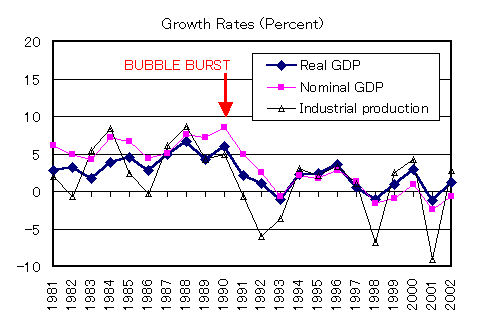
The big question is: why the Japanese economy remains so weak so many years after the bubble burst? Economists are still debating this.
(1) One explanation is purely cyclical. Since the bubble period created large overcapacity, it will take time to reduce capital stock and inventory. But if so, stock adjustment is taking a bit too long.(2) Another explanation blames the banks' non-performing loans. Since banks failed to get rid of bad debt (and the government did not encourage this effectively), financial intermediation was impaired, which in turn hurt the real economy. This vicious circle will continue until a bold measure to clean up the banks' balance sheets is taken (the government is claiming that it is being done, but maybe it is not enough...)
(3) Another popular explanation is that Japan's economic system has become obsolete. Japan's relational systems (lifetime employment, seniority system, keiretsu groups, subcontracting, and so on) may have worked well during the 1950s and 60s, but they are no longer efficient in the age of globalization. Some argue that Japan is facing the third major transformation (the first was in Meiji, the second was post-WW2 reforms). But others caution that Japan should not adopt the American system uncritically since some Japanese systems are still useful. Recall the argument about the origin of the Japanese system in lecture 9.
(4) Still another explanation points to the long-term changes of the Japanese society. Japan has a rapidly aging population and snowballing government debt. The Japanese people are uncertain about their future, especially concerning the rising tax burden, availability of jobs, medical care, and the sustainability of pension schemes. This pessimism slows down consumer spending and business investment.
(5) More recently, the lost competitiveness and the "hollowing-out" phenomenon (as firms invest abroad, jobs will disappear at home) of the Japanese manufacturing base are cited as a great threat. The recent rise of China as the factory of the world is raising concern [but China's growth may slow down; China itself has many economic, social and political problems in the age of WTO].
It seems that the lack of political leadership at the top to squarely recognize and solve these problems is the ultimate cause of uncertainty and declining confidence in the Japanese society. People just do not believe that the current government can manage these problems.
In the early 1990s as the asset bubble collapsed, Japanese banks which were lending actively to SMEs and property development projects faced a serious problem. The recession and corporate bankruptcies increased bad debt, and the decline of land and stock prices additionally hurt the banks' balance sheets (the Japanese banks often required land as loan collaterals and engaged in mutual stock holding). As non-performing loans accumulated, the Japanese banks faced difficulty in observing the BIS capital adequacy requirement (for example, a bank's capital should be at least 8% of its risk assets, properly weighted, if it wants to remain an international bank).
In late 1997, the fear of bank defaults had spread. As Yamaichi Securities and Hokkaido Takushoku Bank went bankrupt, the fear turned into reality. Banks tried to improve their BIS ratios by reducing its risky assets (i.e., lending less, especially to SMEs). But this created a credit crunch in the real sector, causing more bankruptcies and further worsening the quality of bank assets. This vicious circle continued from late 1997 to early 1998. Japanese banks were considered untrustworthy, and the "Japan premium" (additional charges to Japanese banks when they borrow internationally) surged. People wondered which bank would fail next. Many savers shifted their deposits from risky banks to safer ones (and postal savings).
In response to the 1997-98 banking crisis, the government created the Financial Supervisory Agency (October 1998) and the Financial Restructuring Commission (December 1998). They were later merged into the Financial Services Agency (2000-01). The government also prepared "public money" up to 60 trillion yen to deal with the bad debt problem, recapitalize banks and manage the closure and merger of weak banks.
The Bank of Japan responded to the 1997-98 crisis by providing ample liquidity. Subsequently, it adopted the "zero interest rate policy" from April 1999. This means that the short-term interbank rate (call rate) which the Bank of Japan can control shall be lowered effectively to zero, except for a very small technical margin. The Bank of Japan tried to end this policy in August 2000 but when the economy further worsened, it was forced to return to the zero interest rate policy. The official discount rate was also reduced to a very low level, from 6% (1990) to 1.75% (1993) and to 0.10% (2001-now).
The financial panic subsided in early 1998. But the general recession continued.
Since the interest rate cannot be reduced below zero (if that happens, people will hold only cash), the Bank of Japan seems to have reached the end of its policy rope. However, there is still strong pressure on the monetary authority to do more to stimulate the economy. For example:
Increase money supply more drastically and by any means. To do so, buy untraditional assets in open market operations [bank and corporate bonds, foreign bonds, mortgage bonds, even stocks?] Previously, the Bank of Japan bought and sold only government bonds.Inflation targeting: according to the proponents of this idea, the Bank of Japan should announce a positive target rate for inflation for the next 2-3 years and be held responsible for achieving it. At the same time, the Bank of Japan should be insulated from the political pressure of the government. Inflation targeting is considered necessary to change people's expectations about future inflation. Paul Krugman (Princeton University), Alan Meltzer (Carnegie-Mellon University), Takatoshi Ito (Tokyo University), and Motoshige Itoh (Tokyo University) support this idea. But others, including the Bank of Japan economists like Kunio Okina and Kazuo Ueda are skeptical, saying that even if the Bank of Japan tried, there would be little impact because the monetary transmission mechanism is broken. I tend to agree with Okina and Ueda.
Yen depreciation: according to this view, aggressive monetary expansion, coupled with a political statement to welcome yen depreciation, will improve Japan's competitiveness and stimulate the economy. Sometimes the government and the Bank of Japan seem to endorse this strategy, and the yen actually depreciates moderately when such policy intention is announced. But clearly, currency depreciation is a beggar-thy-neighbor policy and will hurt Japan's trading partners. If the US opposes the yen's further weakening, this policy will have to end. Asian neighbors will also be annoyed. At any rate, exchange rate adjustment cannot solve the long-term structural problem. (One variation of this idea is to ask China to appreciate RMB, instead of depreciating the yen. But I don't like this idea either.)
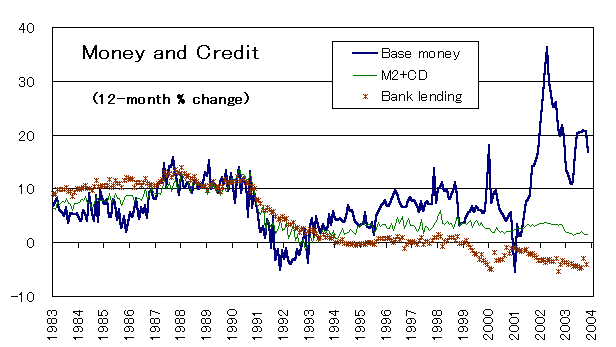
Thanks to the very aggressive foreign exchange intervention by the Bank of Japan to curb the yen's appreciation (i.e., buying dollar assets), Japan's international reserves increased dramatically during 2003. In end December 2003, it stood at $674 billion (up $204 billion from a year ago, or 43% increase !) This, of course, is the largest in the world.
Meanwhile, the American exchange rate policy remains ambiguous. The US government repeats the strange statement that "the policy for a strong dollar is unchanged, but exchange rates should be determined by the market." I don't understand what this means. Especially when the dollar starts to fall due to market pressure, will the US welcome it or resist it? As of 2004 (the year of the US presidential election), it appears that the US is happy with a moderately weak dollar to stimulate the domestic economy.
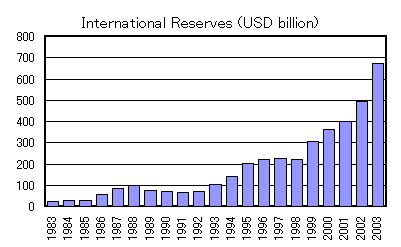
Fiscal policy has been expansionary in the last decade (although some say not expansionary enough relative to what they think is adequate). Based on the official estimates for 2004, the stock of the total government debt (excluding short-term debt and contingent liabilities) will amount to 143.6% of GDP (Nikkei Newspaper, Dec. 20, 2003). This ratio is the highest among major industrial countries. The rating companies have continuously downgraded the Japanese government bond in recent years.
The government is often torn between the need for fiscal consolidation and the need for fiscal stimuli. In recent years, Japan's fiscal policy leaned toward expansionism because of the worsening economic situation. There is always a political pressure for more fiscal stimuli to avoid a "deflation spiral" (price deflation and output recession in a vicious circle). Many contend that "no reform is possible unless the economy improves first." But the effectiveness of fiscal policy under such circumstances is an open question.
The opponents of fiscal activism say that Japan already tried fiscal stimuli many times during the last decade, but the economy failed to recover strongly. They also argue that old-fashioned fiscal spending, such as building expensive but under-used highways, bridges, airports and Shinkansen lines will only benefit rural construction companies while increasing national debt (did Japan really need three giant bridges to span the Inland Sea?) Further fiscal stimuli, which add to the mountain of government debt, may actually weaken the economy through increased fiscal vulnerability and unsoundness. The LDP-based political system, where votes are secured by channeling fiscal spending toward rural supporters, should be ended, it is said. Whether Mr. Koizumi can break through this dilemma while staying within LDP, the den of anti-reform politicians, is yet to be seen. But since 2003, Mr. Koizumi seems to be successful in tightening the fiscal stance relative to the previous years.
Under this circumstance, the traditional IMF conditionality would require Japan to boldly tighten the budget despite short-term pain. But Japan is the biggest lender of the world with the largest international reserves, and it does not need IMF loans to finance the balance of payments. So Japan does not have to listen to the IMF. Maybe that is the problem.
Perhaps we need a deep recession after each bubbleMaybe you want to know what I think of Japan's current situation? My idea about Japan's recession is a bit different from the popular view. I feel that there is too much discussion on how to avoid the deflation spiral. Maybe Japan is trapped in a long recession precisely because of such anti-recession measures. As we learned in this course, Japan experienced a few large bubbles in history. The inflation in early Meiji was stopped intentionally by Matsukata Deflation in the early 1880s. After that, the first company boom occurred and private-sector dynamism was unleashed. Japan's Industrial Revolution started. It appears that each bubble creates overcapacity and a large number of inefficient firms and projects. Unless these are removed, new dynamism is difficult to emerge. Too much human and financial resources, as well as policy attention, are locked into hopeless banks and companies. The best thing the government can do to revitalize the economy is to get rid of them. I think this is more effective than policies to promote IT, venture businesses, technological innovation, etc--we can leave those tasks mostly to the private sector. But in a market-based economy, the government cannot tell individual firms to close doors. The most efficient (but very painful) way to eliminate bad firms and projects is to have a deep but relatively short recession (1-2 years). As finance ministers, Mr. Matsukata and Mr. Inoue implemented such a policy. But today, no Japanese politicians or official economists have the guts to propose it, let alone actually do it. Moreover, there is no political party to support such an austerity policy (unlike Minsei Party did before). We only have LDP which is like Seiyukai Party. Today, Japanese fiscal and monetary policies have been extended beyond their limits. Further stimuli will only worsen the Japanese economy rather than improve it. Both inflation targeting and yen depreciation are bad ideas in this circumstance. Macroeconomic measures have so far prevented a very deep recession from occurring. That is precisely why the Japanese economy is forever saddled with overcapacity and inefficient projects--and the weak economic condition continues. There is a tradeoff between short-term pain and long-term stagnation. Maybe we need more short-term pain. Japan is like a patient being afraid of an operation room. He doesn't want any pain or risk. So his disease never cures. In 2004, thanks to robust Chinese and American demand, Japan is enjoying a mini export boom and the government is triumphant. Does this mean that supply-side clean up is no longer necessary? Time will tell. At any rate, I am more interested in the long-term growth potential of the Japanese economy rather than cyclical phases of global demand. You may have noticed that my view is basically the same as Prof. Banno's (box in lecture 8). |
<References>
Ohno, Kenichi, "Nihon Keizai, Micro karano Saisei o" (Renewal of Japan's Economy Begins from Microeconomic Cleanup), Nihon Keizai Shimbun, December 31, 2002.
Yoshitomi, Masaru, Nihon Keizai no Shinjitsu: Tsusetsu o Koete (The Truth of the Japanese Economy: Beyond Popular Views), Toyo Keizai Shimposha, 1998.